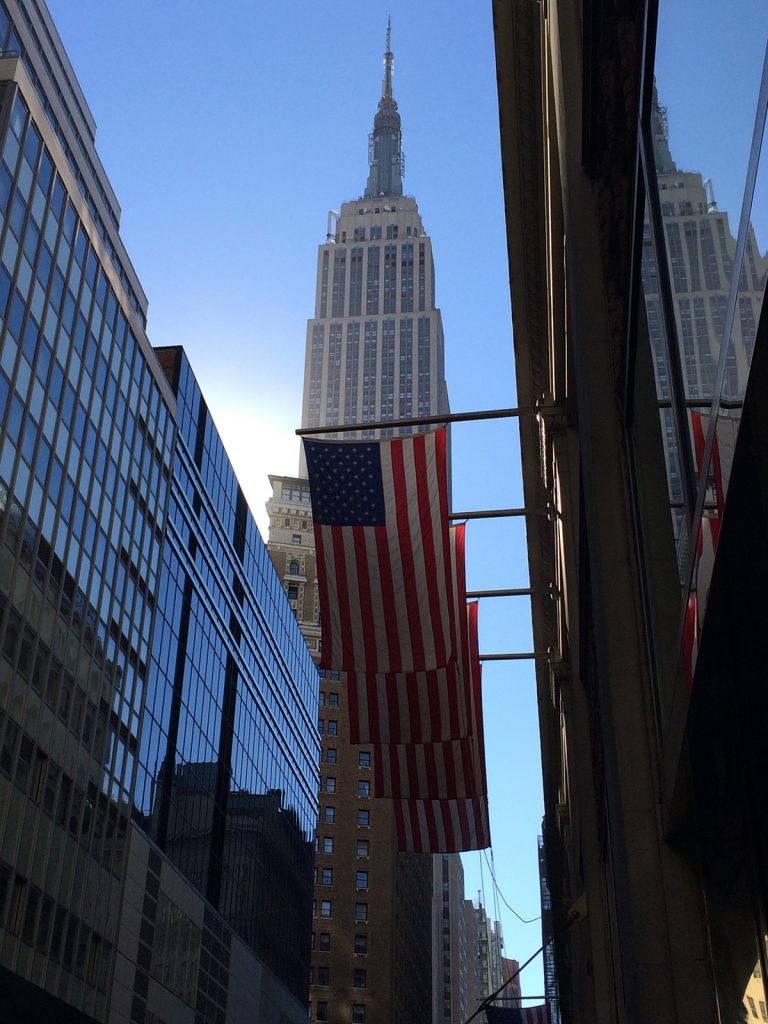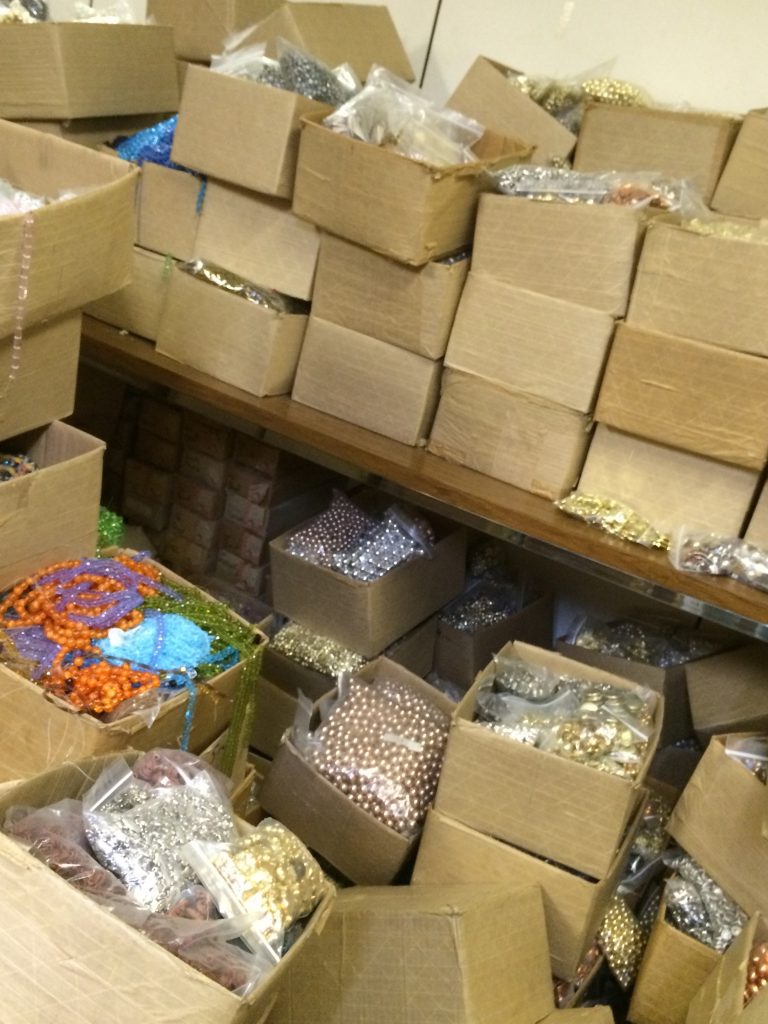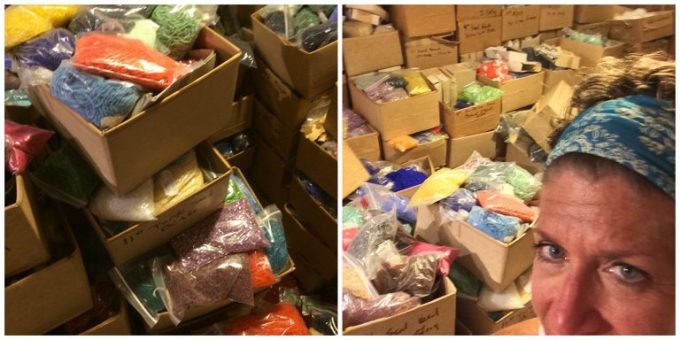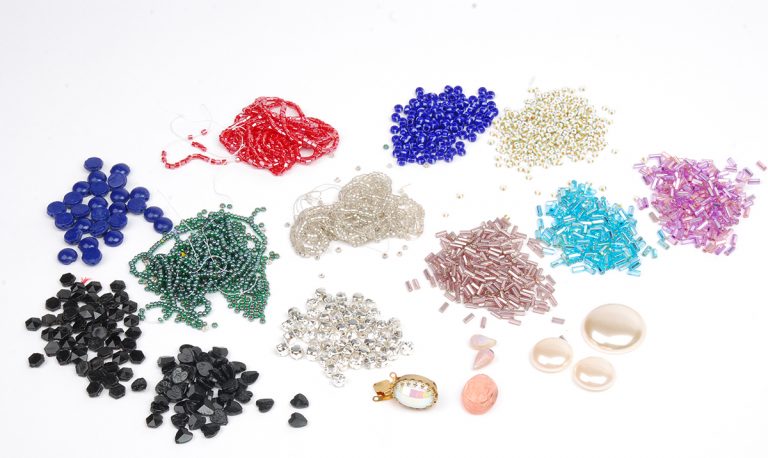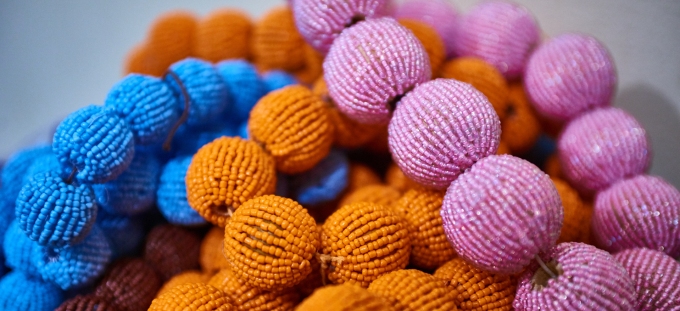 CJS SALES
CJS SALES
TREASURE TROVE FOR THE VINTAGE AND THE UNSUAL [Repost from  click to read]
click to read]
WRITTEN BY: NICOLE LAU
PHOTOGRAPHY BY: NINA DUNCAN
Carl and Elyse Schimel specialize in the vintage and the unusual. Their warehouse, CJS Sales, is stacked floor to ceiling with boxes of vintage deadstock jewelry and accessory making components. The father and daughter team opened the business in 2002 and is called a treasure trove by many designers not only because of their magnificent finds but because they literally must dig for their wares.
Buyers who shop at CJS Sales know the drill. It is not a place to look for a specific item, rather it is a place to become inspired by the items they unearth.
“One of the things CJS is really set up to do is to be a designer quarry,” says Elyse. “Even if somebody is producing overseas, they come here, get inspired for their next collection, make their samples, and figure out what their next big masterpiece is going to be.”

A MUSEUM TO SHOP IN
Elyse and Carl amass goods to fill their warehouse from fire sales. They’ll buy an entire factory or business closing out or liquidating excess inventory way below market prices such as crystal parts from a chandelier store or Swarovski rhinestones from a rhinestone factory. Those savings are passed on to their customers who receive vintage pieces at prices unmatched anywhere else. The majority of the merchandise is sold by the pound, like their vintage stones, although select items are sold by the piece, pack, or box depending on how the item is originally packaged.
Conveniently located next to a parking garage, designers sometimes come with trucks, dig for days on end, and walk out with $100,000 worth of vintage merchandise to resell or rework, giving the items a second life.
In another light, CJS Sales can be thought of as a museum, an archive of the jewelry and accessory industry, because the contents of each room offers a history lesson. There is pressed glass from the 1920s art deco period, some from occupied Japan and others from West Germany. Occasionally items can be dated based on the packaging. If a box says Czecho—Slovakia, its contents would be from 1918 to 1938. If it says Czechoslovakia, it would be 1938 to 1983, and CzechRepublic, 1983 and later. Similarly, their vintage Swarovski crystals, sold by the pound, would read SK Swarovski or DS Swarovski.
Also in the warehouse are West German vintage plastic (lucite), bakelite (a synthetic plastic that became popular in the 1920s and 1930s to make jewelry), cameos, and ebony wood to name a few other offerings. One entire room is filled with finished vintage deadstock which is popular among costume designers from period movie sets because the easiest way to dress the extras is through accessories, belts, earrings, and other jewelry pieces from the decade.
It is common for designers to climb on top of boxes to pick out a bag of venetian seed beads or walk on tangled piles of vintage chain to get to their next excavation site. But the rule at CJS Sales is, if you hurt yourself, you can’t come back. (No one has yet.)
By the entrance of the warehouse are high-end finished vintage jewelry, some with hang tags and earring display cards bearing the company name Kim Craftsmen in gold lettering. CJS Sales occupies the entire 2nd floor of 16 W. 36th Street but from 1950 to 1997, it was the showroom for Kim Craftsmen, Carl’s former jewelry empire.
Conveniently located next to a parking garage, designers sometimes come with trucks, dig for days on end, and walk out with $100,000 worth of vintage merchandise to resell or rework, giving the items a second life.
In another light, CJS Sales can be thought of as a museum, an archive of the jewelry and accessory industry, because the contents of each room offers a history lesson. There is pressed glass from the 1920s art deco period, some from occupied Japan and others from West Germany. Occasionally items can be dated based on the packaging. If a box says Czecho—Slovakia, its contents would be from 1918 to 1938. If it says Czechoslovakia, it would be 1938 to 1983, and CzechRepublic, 1983 and later. Similarly, their vintage Swarovski crystals, sold by the pound, would read SK Swarovski or DS Swarovski.
Also in the warehouse are West German vintage plastic (lucite), bakelite (a synthetic plastic that became popular in the 1920s and 1930s to make jewelry), cameos, and ebony wood to name a few other offerings. One entire room is filled with finished vintage deadstock which is popular among costume designers from period movie sets because the easiest way to dress the extras is through accessories, belts, earrings, and other jewelry pieces from the decade.
It is common for designers to climb on top of boxes to pick out a bag of venetian seed beads or walk on tangled piles of vintage chain to get to their next excavation site. But the rule at CJS Sales is, if you hurt yourself, you can’t come back. (No one has yet.)
By the entrance of the warehouse are high-end finished vintage jewelry, some with hang tags and earring display cards bearing the company name Kim Craftsmen in gold lettering. CJS Sales occupies the entire 2nd floor of 16 W. 36th Street but from 1950 to 1997, it was the showroom for Kim Craftsmen, Carl’s former jewelry empire.
THE ERA OF KIM CRAFTSMEN
When Carl and his brother Marty started Kim Craftsmen in 1950, fashion was completely controlled. The population was searching for a way to express themselves and they couldn’t do it by the fashion in the department stores. If a girl wanted pierced ears, she couldn’t get it at Macy’s or Gimbels. But she could in Greenwich Village because it was liberal. Even the coffee they served was in a foreign name like espresso and cappuccino, which was unheard of at the time. That was the market the brothers catered to.
Throughout the fifty years, Kim Craftsmen made accessories that were attention-grabbing in style and expressed the wearer’s desired identity. Their caged stone necklaces, one of their early creations, was popular for decades. Hand-bent metal wire encased a stone of a different color, size, and shape and allowed women to choose the unique design of their preference. Also in the 1950s, they produced a line of small pierced earrings for rebellious girls wanting to differentiate themselves from their parents’ generation who still wore clip-on and screw back earrings.
In the late 1960s, the brothers were on the forefront of body jewelry. They designed oversized rings and Cleopatra style wristlets along with more daring pieces such as metal bras with opal nipples and chainmail metal vests which were used to dress department store mannequins and resulted in an influx of letters from appalled consumers. Although the body jewelry was not intended for general public wear, it established a look to emulate and women would buy a toned-down version of the wristlet or copper ring on display. Today, the pieces are collectables.
For the first fifteen years, Kim Craftsmen sold their accessories on the street to local college students, visitors to New York, the “weekend bohemian girls,” and to boutiques because department stores focused on older, more established clientele with a disposable income. But after the Schimel bothers established a loyal customer following, the department stores used them as a leader to bring in the junior market.
Kim Craftsmen was one of the first to use in-store kiosks to attract young women into the department stores and make them feel welcomed. Using this marketing technique, department stores sold about 1,000 pairs of their earrings a day. At around $3 a pair, the sales generated a revenue of $3,000, an amount higher than the rest of the entire jewelry department combined.
Carl and Marty didn’t have any formal design training but took naturally to metalwork. They learned from trial and error and as the business grew, they trained each of their 300 employees as quality craftsmanship was extremely important. Kim Craftsmen filled six and a half floors of the building and when they stopped production in 1997, they had made over 100 million pieces of jewelry.
Throughout the fifty years, Kim Craftsmen made accessories that were attention-grabbing in style and expressed the wearer’s desired identity. Their caged stone necklaces, one of their early creations, was popular for decades. Hand-bent metal wire encased a stone of a different color, size, and shape and allowed women to choose the unique design of their preference. Also in the 1950s, they produced a line of small pierced earrings for rebellious girls wanting to differentiate themselves from their parents’ generation who still wore clip-on and screw back earrings.
In the late 1960s, the brothers were on the forefront of body jewelry. They designed oversized rings and Cleopatra style wristlets along with more daring pieces such as metal bras with opal nipples and chainmail metal vests which were used to dress department store mannequins and resulted in an influx of letters from appalled consumers. Although the body jewelry was not intended for general public wear, it established a look to emulate and women would buy a toned-down version of the wristlet or copper ring on display. Today, the pieces are collectables.
For the first fifteen years, Kim Craftsmen sold their accessories on the street to local college students, visitors to New York, the “weekend bohemian girls,” and to boutiques because department stores focused on older, more established clientele with a disposable income. But after the Schimel bothers established a loyal customer following, the department stores used them as a leader to bring in the junior market.
Kim Craftsmen was one of the first to use in-store kiosks to attract young women into the department stores and make them feel welcomed. Using this marketing technique, department stores sold about 1,000 pairs of their earrings a day. At around $3 a pair, the sales generated a revenue of $3,000, an amount higher than the rest of the entire jewelry department combined.
Carl and Marty didn’t have any formal design training but took naturally to metalwork. They learned from trial and error and as the business grew, they trained each of their 300 employees as quality craftsmanship was extremely important. Kim Craftsmen filled six and a half floors of the building and when they stopped production in 1997, they had made over 100 million pieces of jewelry.
THE SECRET TO SUCCESS
The skill set that made Carl successful throughout the 50 years is the same skill set he used in establishing CJS Sales with his daughter. Success, according to Carl, is not based on the timeframe you are in but how you interpret the market of that timeframe and satisfy that particular market. Similar to how Kim Craftsmen found a niche within the younger generation and gave them what they wanted, CJS Sales recognizes the need of the designers and supplies them with the materials to create.
Designers will not go to Michael’s or Jo-Ann Fabrics and Crafts because those stores are meant for hobbyists. They could possibly seek online vendors but would prefer not to because they want to feel the product and understand its characteristics which can’t be realized from a digital image. Carl uses the example of a new a car to explain the importance of in-person purchases.
“Why don’t they go online? It’s the same reason a guy goes to buy a car. He comes in the showroom to check the tires. You got a picture of a car and it’s a beautiful champagne mist, gold car. It’s another thing when you go in and look at it. It reflects light differently, it has a different intensity… [Designers] come to us because if I send them a picture of the item, they can’t get the depth of the item exactly. Now this is extremely important to a designer. When you are talking to a designer, it is how they view it, how it looks to them.”
A designer may determine that the turquoise cabochon is alright but the green isn’t. Or that the rhinestone’s purple color actually looks deeper than depicted in the photograph. It is this knowledge of how the design industry operates, in addition to the quality items they stock, that has made CJS Sales a destination location.
Designers will not go to Michael’s or Jo-Ann Fabrics and Crafts because those stores are meant for hobbyists. They could possibly seek online vendors but would prefer not to because they want to feel the product and understand its characteristics which can’t be realized from a digital image. Carl uses the example of a new a car to explain the importance of in-person purchases.
“Why don’t they go online? It’s the same reason a guy goes to buy a car. He comes in the showroom to check the tires. You got a picture of a car and it’s a beautiful champagne mist, gold car. It’s another thing when you go in and look at it. It reflects light differently, it has a different intensity… [Designers] come to us because if I send them a picture of the item, they can’t get the depth of the item exactly. Now this is extremely important to a designer. When you are talking to a designer, it is how they view it, how it looks to them.”
A designer may determine that the turquoise cabochon is alright but the green isn’t. Or that the rhinestone’s purple color actually looks deeper than depicted in the photograph. It is this knowledge of how the design industry operates, in addition to the quality items they stock, that has made CJS Sales a destination location.
ENTREPRENEURSHIP & OLD GARMENTO HUMOR
When Elyse visited her father at the factory growing up, she didn’t sit in the corner and read, she participated. At the age of nine, Elyse remembers working on the assembly line, painting the jewelry and learning how to design. When she was getting her doctorate degree, Carl thought she needed some “busy work” so Elyse began selling Kim Craftsmen merchandise as he liquidated the business. Carl, who started selling on the street at the age of 16, wanted Elyse to learn self-efficacy.
“We’d hear stories about family businesses, someone going to the school and saying, ‘I don’t care if my kid is bright, I don’t want them in calculus. I want them in bookkeeping,’” says Elyse. “Parents come in with their teenage age kid and get them to help with the business.”
Growing up, the emphasis was on learning by doing, to prepare for the workforce by encouraging kids to get a job. Elyse is a clinical psychologist but believes she would have been as successful in establishing CJS Sales with her father coming out of high school because she worked in the family business. The norm now is for everyone to attend college but Elyse argues that college isn’t right for everyone.
Five years ago, one designer was buying finished goods to resell online and making $200,000 in profit. She dropped out of college because there was nothing more to learn that she didn’t already do herself. Carl was already profitable by the time he enrolled in NYU Stern. A job is to support yourself and make money, but it is also the best form of education.
“We’d hear stories about family businesses, someone going to the school and saying, ‘I don’t care if my kid is bright, I don’t want them in calculus. I want them in bookkeeping,’” says Elyse. “Parents come in with their teenage age kid and get them to help with the business.”
Growing up, the emphasis was on learning by doing, to prepare for the workforce by encouraging kids to get a job. Elyse is a clinical psychologist but believes she would have been as successful in establishing CJS Sales with her father coming out of high school because she worked in the family business. The norm now is for everyone to attend college but Elyse argues that college isn’t right for everyone.
Five years ago, one designer was buying finished goods to resell online and making $200,000 in profit. She dropped out of college because there was nothing more to learn that she didn’t already do herself. Carl was already profitable by the time he enrolled in NYU Stern. A job is to support yourself and make money, but it is also the best form of education.
In addition to acquiring her father’s strong work ethic, Elyse also picked up an appreciation for the old garment industry’s uncensored humor. She readily shares the time when her father told the drag queen who shops at the warehouse, “I tell everyone that the best set of tits comes with a nice pair of balls!” Elyse’s and Carl’s tenacity and discipline with a touch of jocularity make them ideal business partners.
Elyse lives in Florida but returns to New York once or twice a month when a big customer is scheduled to visit. She would watch the business through cameras that would stream live feed to her phone and call the office to ask her father, why are you in the back doing that? Or to remind him that he forgot to open the gate. One day, the camera feed mysteriously went out. Carl later said to her, “I’ve been in business for seventy years. I don’t need you to manage me from Florida!”
Author’s Note:
Author’s Note:
One week after the interview, before this profile was completed, Carl was told his lease would not be renewed after 66 years as a tenant at 16 W 36th Street. Carl, who is 82, and continues to work 6 days a week, (only allowing himself one vacation a year to go fishing) hoped to spend the remainder of his career in the building he started in but was not given an option to negotiate a new contract. The building managers prefer to have a different (non-garment related) clientele. This occurrence is unfortunately not uncommon in New York’s Garment District. 2013 was the first year the number of non-garment related business outnumbered garment-related businesses and that number continues to rise. In the past three years alone, 13 of Carl’s friends have gone out of business.


















